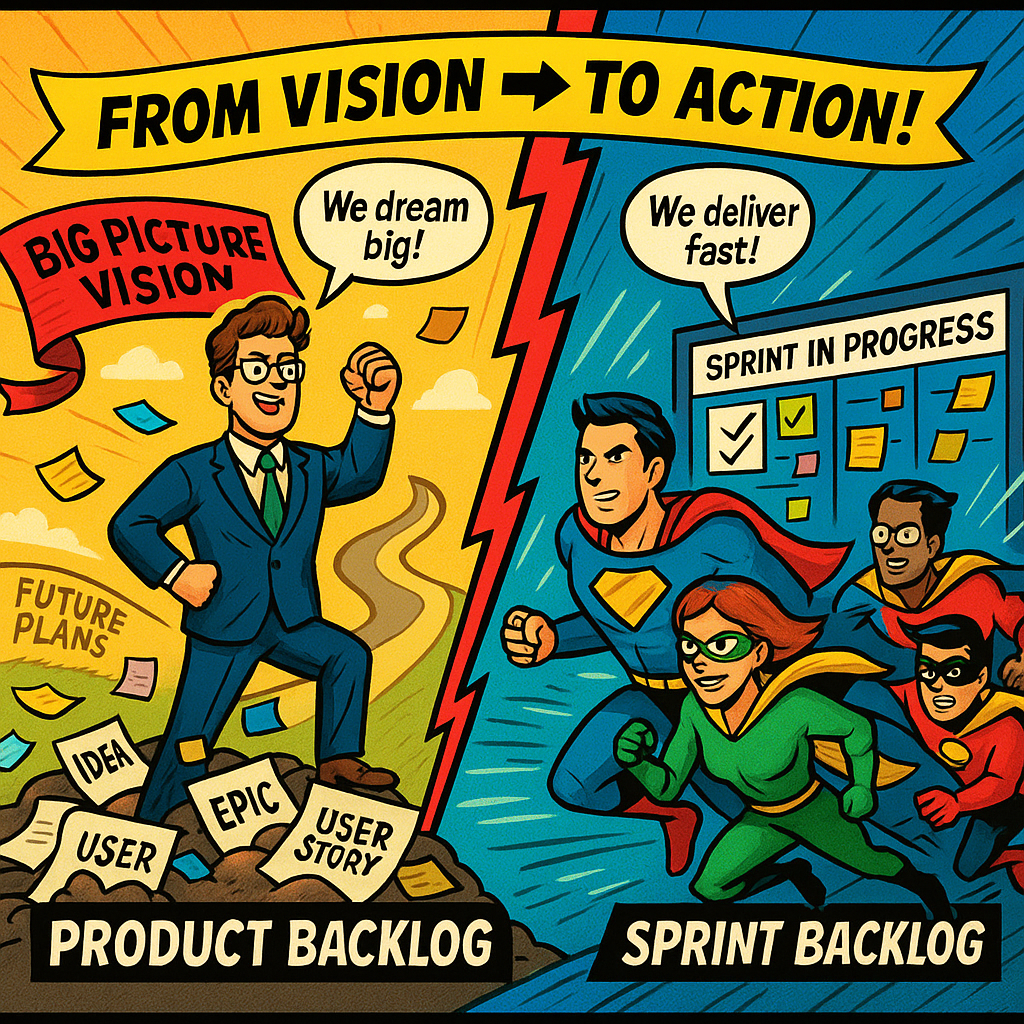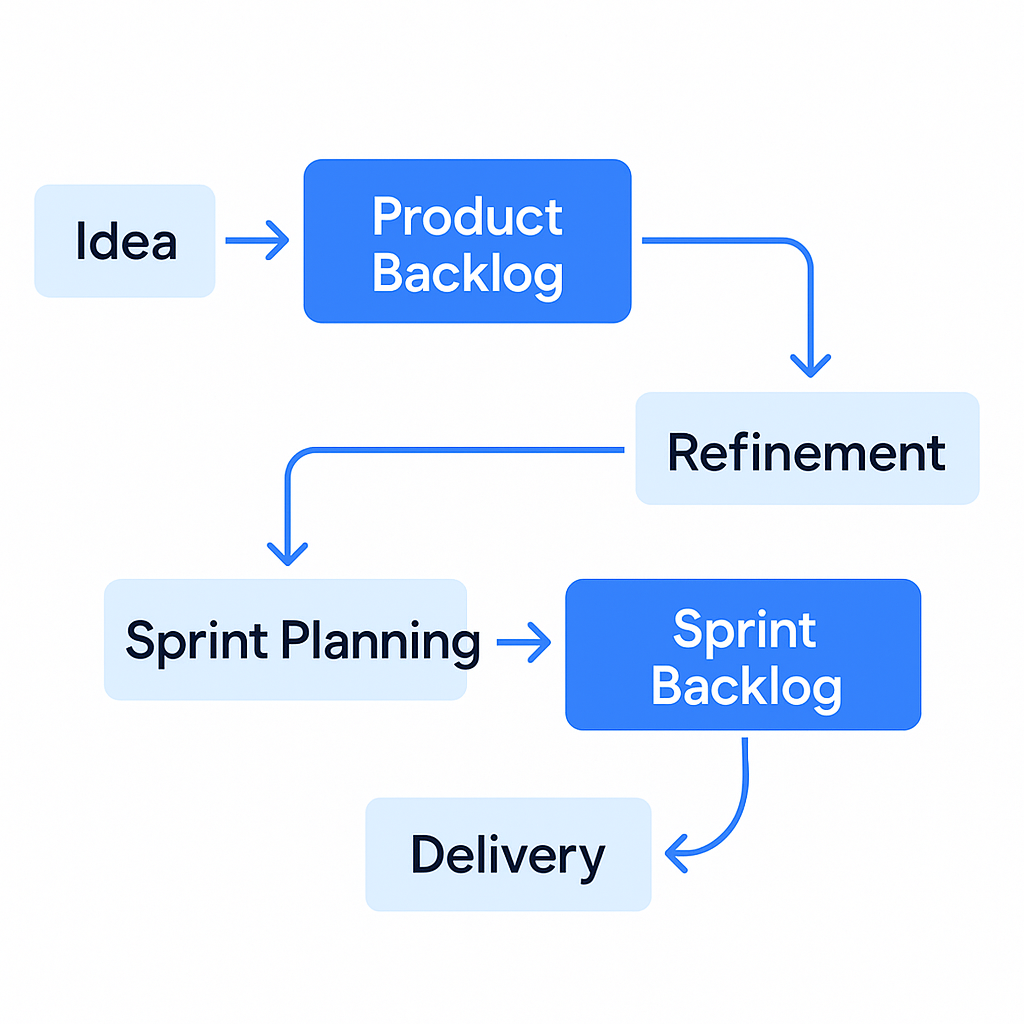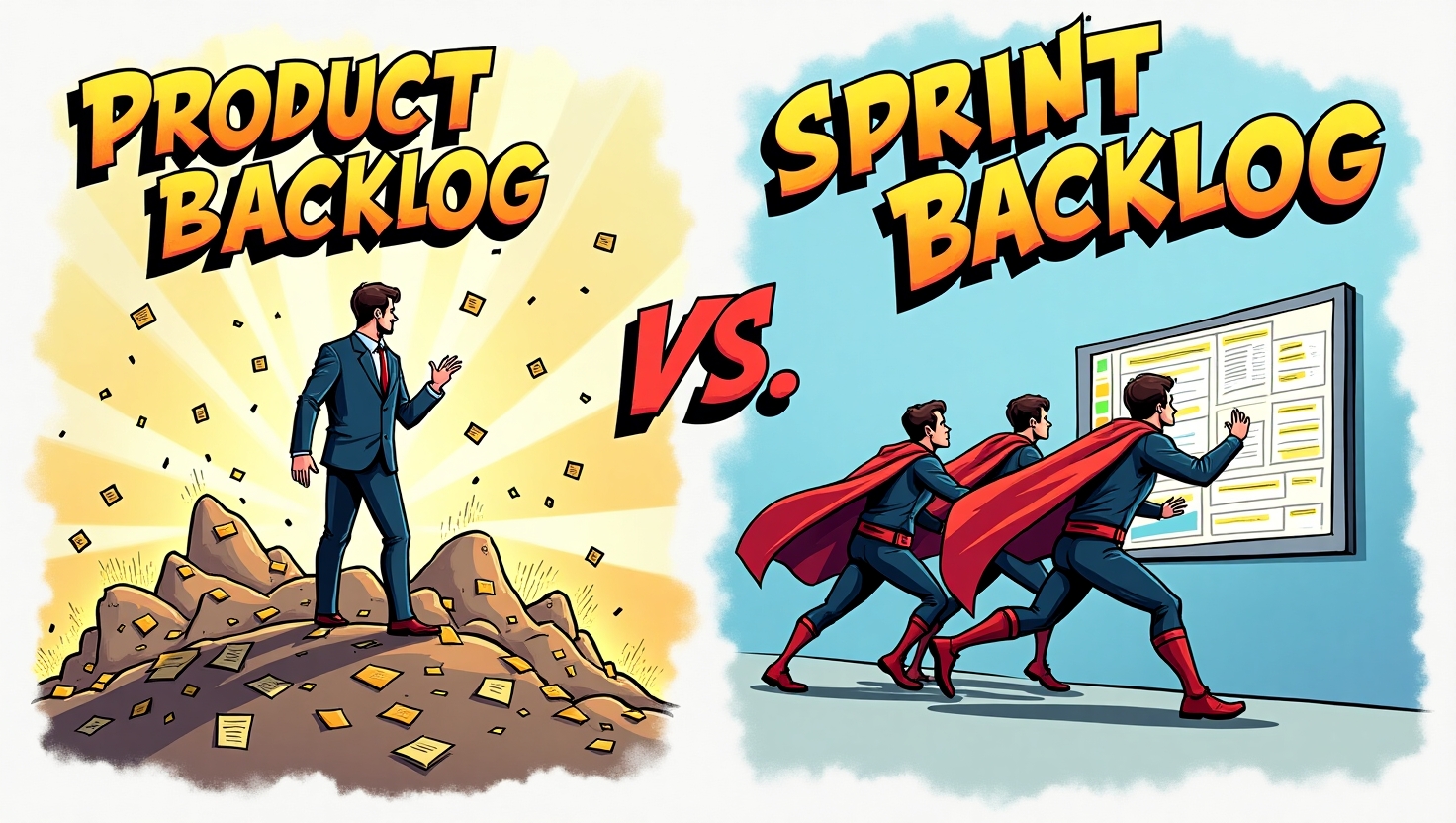If you’ve dipped your toes into the world of Agile project management, you’ve likely come across the terms product backlog and sprint backlog. They sound pretty similar, and honestly, in casual conversations, people sometimes even mix them up. But here’s the thing – they serve two very different purposes. And not knowing the difference? That can create a mess in your project flow.
Understanding how these two backlogs operate – and how they connect – is one of the cornerstones of smooth Agile delivery. Whether you’re a Product Owner trying to prioritize your roadmap, or a developer aiming to stay focused during sprints, this clarity matters.
Let’s break it all down, starting from the top.
Table of Contents
What is a Product Backlog?
Think of the product backlog as your ultimate to-do list for building the entire product. It’s dynamic, always evolving, and shaped by continuous feedback. It doesn’t tell you how things will get done in each sprint – that’s where the sprint backlog comes in – but it does capture what needs to be done to deliver a valuable product over time.
Who creates and maintains it?
The Product Owner is in charge of the product backlog. But it’s not created in isolation. It’s built with input from stakeholders, customers, users, and the development team. It’s a living document that reflects the team’s current understanding of what the product should become.
What goes inside a product backlog?
Here’s what you typically find:
- Epics – Large features or initiatives that will be broken down over time.
- User Stories – Smaller, actionable items from a user’s perspective.
- Features – Sometimes interchangeable with stories, but often higher level.
- Technical Debt – Refactors or cleanup work that’s needed.
- Bugs – Yep, those live here too.
Prioritization Techniques
This is where product ownership becomes an art form. Not everything can be urgent. Here are a few frameworks to help prioritize:
- MoSCoW (Must have, Should have, Could have, Won’t have)
- WSJF (Weighted Shortest Job First – often used in SAFe environments)
- Kano Model – Helps evaluate features based on customer delight
What is a Sprint Backlog?
Now let’s zoom in a bit. If the product backlog is the big picture, the sprint backlog is the specific chunk of work your team commits to during the current sprint.
It’s like saying: “We’re going to focus only on these few items over the next two weeks. Let’s go!”
When and how is it created?
The sprint backlog is created during the Sprint Planning meeting. The development team looks at the product backlog, chooses the top-priority items that fit the Sprint Goal, and breaks them down into actionable tasks.
This is their commitment for the sprint. Once finalized, the team owns it.
What’s inside a sprint backlog?
- Selected User Stories – Chosen based on sprint goals and team capacity
- Subtasks – Specific tasks to complete each story
- Acceptance Criteria – Conditions that define when a story is considered “done”
- Bugs (if needed) – Usually only if they align with the sprint goal or are blocking progress
Difference Between Product Backlog and Sprint Backlog
Here’s where it really matters. If you’re running Agile, you need to respect the boundaries between these two tools. Let’s lay it out clearly:

| Criteria | Product Backlog | Sprint Backlog |
| Definition | A prioritized list of everything that might be needed in the product. It’s the single source of truth for all product work. | A subset of the product backlog that the team commits to completing during a specific sprint. |
| Purpose | Guides long-term product development by outlining what should be built and why. | Focuses on short-term delivery by outlining how selected items will be implemented. |
| Ownership | Owned and managed by the Product Owner. | Owned and managed by the Development Team. |
| Contributors | Product Owner, stakeholders, Scrum Master, development team, customers, users. | Entire development team (during sprint planning), sometimes with Product Owner’s input. |
| Scope | Represents the entire product or project roadmap. | Focuses only on what will be delivered in the current sprint. |
| Time Horizon | Long-term and strategic. | Short-term and tactical (typically 1-4 weeks). |
| Level of Detail | High-level for future items; more detailed for near-term work. | Highly detailed; includes technical tasks, subtasks, and acceptance criteria. |
| Contents | Epics, user stories, features, bugs, tech debt, spikes, and enhancements. | Selected user stories, broken-down tasks, bugs to be fixed in sprint, test tasks, documentation, etc. |
| Granularity | Varies. Broad and high-level initially; increases through backlog refinement. | High granularity. Tasks are broken down enough to be completed within the sprint. |
| Flexibility | Highly flexible; constantly evolving based on business needs, feedback, and learning. | Locked during the sprint. Can only change under exceptional circumstances. |
| Prioritization Basis | Business value, user needs, technical dependencies, ROI. | Sprint goal, feasibility, team velocity, and capacity. |
| Prioritization Techniques | MoSCoW, WSJF, Kano, ICE, Value vs Effort matrix. | Ordered by the team during sprint planning, guided by the sprint goal. |
| Created During | Initially during product planning, then continuously refined. | Created during Sprint Planning meeting at the start of each sprint. |
| Updated When | Anytime – especially during backlog refinement sessions. | Daily during the sprint (via stand-ups or task board updates). |
| Reviewed In | Backlog refinement, Sprint Review, and Product Roadmap updates. | Daily Scrum (stand-up), Sprint Review, and Sprint Retrospective (indirectly). |
| Visibility | Shared with the whole team and stakeholders. Often visible through tools like Jira, Trello, or Miro. | Internal to the Scrum team. May be visible to stakeholders but primarily for sprint execution. |
| Change Frequency | Frequent – items can be added, re-prioritized, removed, or updated regularly. | Rare during sprint – changes are discouraged unless sprint goal becomes invalid. |
| Tool Examples | Jira (Product Backlog), Azure DevOps, Trello (Backlog lists), VersionOne, Aha!, Productboard. | Jira (Sprint Board), Trello (Sprint columns), Azure Boards, ClickUp, Asana (Sprint tasks). |
| Success Metric | Alignment with product vision and delivery of business value over time. | Completion of all sprint backlog items by the end of the sprint. |
| Visual Representation | Prioritized backlog list, roadmap, user story map. | Sprint board (Kanban-style), burndown chart, checklist of sprint tasks. |
| Relation to Agile Ceremonies | Central to Backlog Refinement and Sprint Planning. | Created in Sprint Planning, reviewed in Daily Scrum, and evaluated in Sprint Review. |
| Backlog Item Format | Typically written as user stories: “As a [user], I want [function] so that [benefit].” | Task-oriented: technical tasks, QA activities, coding subtasks, and documentation work. |
| Estimated By | Development team during refinement sessions. | Further refined during sprint planning by the development team. |
| Source of Truth For | The overall product direction and feature pipeline. | The sprint execution and the team’s commitment for the current sprint. |

Enroll Now: Product Marketing Course
A few important clarifications:
- Why is the sprint backlog a subset of the product backlog?
Because you can only pull from what already exists. You can’t invent work during sprint planning. The product backlog acts as the menu – sprint backlog is your selected order.
- Level of Granularity:
The product backlog is broader. A user story might just say “Implement password reset.” In the sprint backlog, that becomes: build the UI, handle backend logic, test email notifications, etc.
- Backlog Grooming (a.k.a. Refinement):
This is the process of revisiting, refining, re-prioritizing, and sometimes re-estimating product backlog items. It ensures the product backlog is always ready for sprint planning. Sprint backlog grooming, however, is more of a daily check-in activity during the sprint – adjusting task statuses, splitting work if needed, etc.
The Relationship Between Product and Sprint Backlogs
At first glance, the product backlog and sprint backlog might seem like two separate to-do lists living in their own worlds. But in reality, they’re closely connected – kind of like a roadmap (product backlog) and the turn-by-turn directions (sprint backlog) that help you get to your destination.
Sprint Backlog: A Subset of the Product Backlog
This is a crucial point. Every sprint backlog is built from the product backlog. During sprint planning, the team pulls items from the product backlog that align with the current sprint goal. These are usually high-priority tasks that the team believes can be completed within the sprint timeframe (usually 1-4 weeks).
So, if the product backlog is the universe of “everything we’d love to build someday,” the sprint backlog is “what we’re committing to building right now.”
From Idea to Delivery: The Workflow
Here’s how a typical flow might look:
- An idea is born – maybe from a customer request, stakeholder feedback, or a team brainstorm.
- It lands in the product backlog – usually as a user story or epic.
- It gets prioritized and refined – this is where the Product Owner shines.
- It’s selected during sprint planning – the development team evaluates what they can realistically deliver in the upcoming sprint.
- It becomes part of the sprint backlog – broken down into manageable subtasks, with clear acceptance criteria.
- It gets built, tested, and (ideally) shipped – closing the loop.
To visualize how the product backlog and sprint backlog connect in an Agile workflow, here’s a simple flowchart that maps the journey from idea to delivery:

This visual helps clarify how work moves through the Agile system – from concept to completion.
Also Read: What Is an Epic in Agile
Role of Sprint Planning: The Bridge Between the Two
Sprint planning is the key ceremony that links the product and sprint backlogs. It’s a collaborative session where the team and Product Owner meet to:
- Clarify goals for the sprint
- Select backlog items that serve that goal
- Break them down into actionable pieces
The outcome? A focused, achievable sprint backlog that reflects both business priorities and technical reality.
Who Manages the Backlogs?
Product Backlog: Product Owner’s Playground (Mostly)
The Product Owner (PO) is the gatekeeper of the product backlog. They decide what goes in, what gets prioritized, and what can wait.
But it’s not a solo gig. Great product backlogs come from active collaboration. POs gather input from:
- Stakeholders
- Users
- The development team
- Business leads
They also refine the backlog regularly – this means grooming stories, re-prioritizing based on market or business shifts, and sometimes removing items that no longer make sense.
Sprint Backlog: Dev Team’s Responsibility
Once the sprint backlog is created, the development team takes full ownership. They don’t need permission from the PO to tweak task assignments or update subtasks. It’s their execution zone.
The team will often adjust how they work day to day – adding technical subtasks, re-estimating effort, or shifting focus slightly – as long as the sprint goal remains intact.
Think of it like this:
Product Owner = What we’re building
Dev Team = How we’re building it
Best Practices for Managing Both Backlogs
If you want to keep your Agile engine running smoothly, managing these backlogs well is non-negotiable. Here are some practical tips:
Product Backlog
- Prioritize ruthlessly – not everything is urgent. Use MoSCoW or WSJF to rank items.
- Refine often – set a regular cadence (weekly or bi-weekly) for backlog grooming sessions.
- Avoid over-detailing distant work – don’t waste time writing out perfect stories for Q4 if you’re in Q1. Things change.
- Keep it transparent – everyone should understand what’s in the backlog and why.
Sprint Backlog
- Limit scope – don’t overload it. If a story can’t be finished in the sprint, split it or leave it out.
- Break down tasks – vague stories lead to confusion. Break them into digestible subtasks.
- Update daily – use standups and your board to keep it alive.
- Link it to sprint goals – every item should serve a purpose in the sprint.
Tools You Can Use
- Jira – robust, customizable, widely used in product teams.
- Trello – lightweight, visual, and great for smaller or non-tech teams.
- Azure DevOps – excellent integration with Microsoft stack.
- Notion / ClickUp – great for startups and remote teams.
Also Read: 45+ Best AI Tools for Digital Marketing
Foster Collaboration
Ultimately, backlogs are communication tools. Make sure your team, stakeholders, and leadership are aligned and contributing to them – not just “getting updates.”
Common Mistakes to Avoid
Even seasoned teams stumble into some of these traps:
1. Treating Backlogs as Static
Backlogs aren’t set-and-forget documents. The product backlog should evolve with business goals, and the sprint backlog should reflect actual progress.
2. Mixing Long-Term with Short-Term Planning
Don’t treat the product backlog like a daily to-do list. Likewise, don’t stuff the sprint backlog with items that aren’t fully thought through.
3. Micromanaging the Sprint Backlog
Once the sprint starts, let the dev team run with it. Constant interference from POs or managers breaks flow and kills ownership.
4. Poor Communication Between PO and Dev Team
A strong connection between product vision and day-to-day execution is crucial. Schedule regular check-ins. Avoid the “us vs them” mindset.
Also Read: Agile vs Waterfall: Key Differences
Conclusion
Product backlog and sprint backlog are like two gears in your Agile machine. One sets the big-picture direction, the other keeps the daily progress on track.
- The product backlog is broad, evolving, and business-focused.
- The sprint backlog is narrow, time-boxed, and action-oriented.
When both are well-managed and connected, Agile teams can stay flexible and focused – delivering real value without chaos.
Product Backlog vs Sprint Backlog: FAQs
Q1. Can the sprint backlog change during a sprint?
Usually, no – at least not drastically. Minor task-level adjustments are okay, but the sprint goal should stay fixed.
Q2. Who decides what goes into the sprint backlog?
The development team decides during sprint planning, in collaboration with the Product Owner.
Q3. Is the product backlog only for user stories?
Not at all. It can include epics, features, bugs, spikes, and even technical debts or improvement tasks.
Q4. How often should a product backlog be updated?
Continuously. But formal backlog grooming typically happens once a week or once per sprint.
Q5. Can an item be in both backlogs at once?
Technically, no. Once an item is pulled from the product backlog into a sprint, it becomes part of the sprint backlog.
Q6. What tools help manage product and sprint backlogs efficiently?
Popular choices include Jira, Trello, Azure DevOps, ClickUp, Notion, and Asana – choose based on your team’s workflow and needs.

